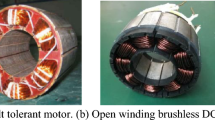Abstract
Application of the intelligent on–off valve reduces heat loss. As the critical control component of the intelligent on–off valve, the health state of the brush DC motor directly impacts whether the intelligent on–off valve can perform the regular operation. Therefore, the reliability evaluation of the brush DC motor is of great significance to the whole heat supply network. In this study, the failure mechanism of the brush DC motor is analyzed, and the absolute value of steady-state current variation is taken as the performance degradation characteristic parameter. According to the performance degradation characteristic parameter, the performance degradation model based on the Wiener process is established, and the inverse power rate acceleration model is introduced into the Wiener process to derive the reliability function of the motor. Based on the actual operating conditions that the motor in the intelligent on–off valve needs to start and stop frequently, an accelerated life test based on start-stop is designed. The error analysis result shows that the error between the expected start-stop times predicted by the proposed and the actual average failure start-stop times is only 2.14%. The proposed degradation model is more accurate than the motor's traditional performance degradation model.














Similar content being viewed by others
References
W Xi, Y Tong, B Qiu, Z Liu and X Xu (2018) "Prediction of product degradation in outside environment based on cumulative damage degradation model," 2018 prognostics and system health management conference (PHM-Chongqing), pp. 229–233, 2018.
H Wang, C Ma and N Chen (2010) "A brief review on item response theory models-based parameter estimation methods," 2010 5th international conference on computer science & education, pp. 19–22, 2010.
Min Luo and Tongmin Jiang (2009) "Step stress accelerated life testing data analysis for repairable system using proportional intensity model," 2009 annual reliability and maintainability symposium, pp. 360–364, 2009.
Dey AK, Kundu D (2009) Discriminating among the log-normal, weibull, and generalized exponential distributions. IEEE Trans Reliab 58(3):416–424
Go HY, Sung SI, Kim YS (2018) Prediction of system reliability using failure types of components based on Weibull lifetime distribution. J Mech Sci Technol 32:2463–2471
Du X, Li G, Liu H, Sun P, Zhou L (2015) Effect of wind speed probability distribution on lifetime of power semiconductors in the wind power converters. Trans China Electrotech Soc 30(15):109–117
Gu D, Gao J, Zhong Y et al (2021) Scale parameter assessment based on pivot quantity for reliability analysis of a complex system. J Mech Sci Technol 35:1007–1015
Jeong K, Kim Y, Kim C et al (2020) A study on the statistical life span estimation of aged low-voltage circuit breakers. J Electr Eng Technol 15:2833–2839
Wang H, Teng K (2017) Review of reliability evaluation technology based on accelerated degradation data. Sys Eng Electron 39(12):2877–2885
Li K, Duan Y, Sh Huang Sh, Liu ZZ, Wu Y, Zhou C (2018) Residual electrical life prediction of AC contactor based on the Wiener Process. Proc CSEE 38(13):3978–3986
Shu X, Guo Y, Yang H et al (2021) Reliability study of motor controller in electric vehicle by the approach of fault tree analysis[J]. Eng Fail Anal 121(12):105165
Li H, Chen T (2017) Demagnetization fault diagnosis and fault mode recognition of PMSM for EV. Trans China Electrotech Soc 32(05):1–8
Li W, Cheng M (2018) Markov reliability model analysis of flux-switching permanent magnet machine. Trans China Electrotech Soc 33(9):4535–4543
D Zheng, H Li, Z Zhang, J Wu and J Xu (2011) "Study on the life prediction of induction motors based on accelerated degradation testing method," The proceedings of 2011 9th international conference on reliability, maintainability and safety, pp. 1101–1106.
Huang H, Lin R (2000) Analysis of BLDCM reliability and failure model. Electric Machines Control 04:198–201
Zeng D, Sun L, Zhou L et al (2019) Reliability evaluation of IGBT performance degradation characteristic parameters based on accelerated aging test. Adv Technol Electric Eng Energy 38(07):20–28
Liu X, Li X, Yang L et al (2020) Prediction of SMT solder joint fatigue life. New Technol New Process 11:70–75
Galleani L, Cohen L (2006) The generalized wiener process for colored noise. IEEE Signal Process Lett 13(10):608–611
Li K, Zh Gao YWu et al (2019) Remaining lifetime prediction of AC contactor based on statistical regression and nonlinear Wiener process. Trans China Electrotech Soc 34(19):4058–4070
Whitmore GA, Schenkelberg F (1997) Modelling accelerated degradation data using wiener diffusion with a time scale transformation. Lifetime Data Anal 3(1):27–45
Wu S, Lu J, Li X (2021) Review of reliability accelerated life test. Electronic Product Reliability Environ Testing 39(01):94–100
Wang P, Zhang Z (2021) A particle filter method for brush wear prediction of direct current motor. Micromotors 54(08):43–46
Zhao H, Fu X, Xie Zh et al (2018) Research on reliability of DC motor in damp heat and salt mist environment. Micromotors 51(09):29–31
Author information
Authors and Affiliations
Corresponding author
Additional information
Publisher's Note
Springer Nature remains neutral with regard to jurisdictional claims in published maps and institutional affiliations.
Rights and permissions
Springer Nature or its licensor holds exclusive rights to this article under a publishing agreement with the author(s) or other rightsholder(s); author self-archiving of the accepted manuscript version of this article is solely governed by the terms of such publishing agreement and applicable law.
About this article
Cite this article
Yang, T., Li, S., Duan, S. et al. Performance Degradation Model and Reliability Evaluation of Brush DC Motor for the Intelligent on–Off Valve. J. Electr. Eng. Technol. 18, 1909–1918 (2023). https://doi.org/10.1007/s42835-022-01222-z
Received:
Revised:
Accepted:
Published:
Issue Date:
DOI: https://doi.org/10.1007/s42835-022-01222-z




